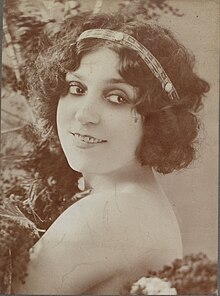| Régina Badet | |
|---|---|
 Régina Badet by Jean Reutlinger Régina Badet by Jean Reutlinger | |
| Born | Anne Régina Badet 9 October 1876 Bordeaux, French Third Republic |
| Died | 26 October 1949 (aged 73) Bordeaux, France |
| Occupation(s) | Actress, Dancer |
| Spouse |
François Merman (m. 1946) |
Anne Régina Badet (9 October 1876 – 26 October 1949) was a French comedic actress, dancer, and star of the Ópera-Comique de Paris.
Career

Badet was first dancer with the Grand Théâtre de Bordeaux in 1890. She began with the Opéra-Comique de Paris in 1904, dancing in productions of Lakmé (1905), Aphrodite (1906, in which she shared billing with dancer Mata Hari), Ariane et Barbe-Bleue (1907), Carmen (1908), Bacchus triomphant (1909), Le Mariage de Télémaque (1909), Athanaïs (1910), Sapphô (1912), La Grande Famille (1914), Un Mari dans du Coton (1916), Les Trois Sultanes (1917), Appassionata (1920), and Le Venin (1923). She was known for creating the role of Conchita Perez in a stage adaptation of La Femme et le Pantin (1910), in which her very minimal costume was a matter of some scandal.
Badet appeared in French silent films Le Secret de Myrto (1908), Le Retour d'Ulysse (1909), Carmen (1910), La Saltarella (1912), Zoé a le cœur trop tendre (A Woman's Last Card, 1912), Le Spectre du passé (1913), Vendetta (1914), Manuella (1916), Le Lotus d'or (The Golden Lotus, 1916), Sadounah (No Greater Love 1919), and Maître Évora (1922).
Her dances were often in the popular exotic style, referencing ancient or "oriental" themes. "Mlle. Badet does not seem to content herself with the lavish display of her charmingly pretty figure," commented an American writer, "but to run the gamut from the somewhat acrobatic and to our eyes grotesque posturing and 'stunts' which found so much favor with the ancients, to dances of ideas and emotions of a much higher and more poetic order, mingled with passages of adoration of and oblation to the goddess whom she serves." An American publication described her as "A Dancing Bernhardt," quoting her as saying "Every woman can live artistically," and "Nature never intended that a single woman should be plain or unattractive."
Badet was considered a great beauty of the Paris stage. A rose variety was named "Regina Badet" in 1909. During World War I she was active in the Union des Arts, theatrical professionals in Paris raising funds for war relief.
Personal life
The Château Marbuzet in Bordeaux was reportedly built for Badet at great expense. It still stands as part of a vineyard. Pianist Arthur Rubinstein described a shipboard affair with Badet, on their way to Argentina in 1917. Badet died in 1949, aged 73 years, in Bordeaux. She was survived by her husband of three years, François Merman.
In 2016, Régina Badet was played by actress Hélèna Soubeyrand in a French film, Chocolat, about the Paris stage of the late nineteenth century.
References
- "Family tree of Anne Regina BADET". Geneanet.
- Garafola, Lynn (2005-01-28). Legacies of Twentieth-Century Dance. Wesleyan University Press. pp. 149, 163–164. ISBN 9780819566744.
Regina Badet.
- "The Poetry of the Ancient Dance on the Modern Stage". The Sketch. 54: 332. June 20, 1906.
- "Music in Paris". Musical Courier. 54: 11. June 5, 1907.
- "Music in Paris". Musical Courier. 56: 13. January 15, 1908.
- Colburn, Frona Waite (February 1910). "Vintage Day". Sunset Magazine. 24: 206.
- Mendès-Leite, Rommel; Busscher, Pierre-Olivier de (1993). Gay Studies from the French Cultures: Voices from France, Belgium, Brazil, Canada, and the Netherlands. Psychology Press. p. 102. ISBN 9781560244363.
- "Three Favorite French Dancers". Vogue. 41: 49. January 1, 1913 – via ProQuest.
- "Monte Carlo". The New Music Review and Church Music Review. 11: 208. April 1912.
- "Regina Badet at Lyric Today". Asbury Park Press. November 17, 1913. p. 1. Retrieved April 1, 2019 – via Newspapers.com.
- "The Golden Lotus". Motography. 18: 232. August 4, 1917.
- "'The Golden Lotus' at Gamble Theatre". Altoona Tribune. June 26, 1917. p. 3. Retrieved April 1, 2019 – via Newspapers.com.
- "Our Girls Salome Mad". The New York Times. October 11, 1908. p. C2 – via ProQuest.
- Julie McQuinn, "Unofficial discourses of gender and sexuality at the Opéra -Comique during the Belle Epoque" (PhD dissertation, Northwestern University, 2003): 164–170. ProQuest document 305317501.
- Bell, Hamilton (January 1907). "The Renaissance of the Art of Dancing". Appleton's Magazine. 9: 76.
- Liddell, Scott (January 1913). "A Dancing Bernhardt". Cosmopolitan. 54: 271–272.
- "Paris Unable to Pick Reigning Stage Beauty". Sacramento Union. October 22, 1911. p. 1. Retrieved April 1, 2019 – via California Digital Newspaper Collection.
- Nomenclature, American Joint Committee on Horticultural (1923). Standardized Plant Names: A Catalogue of Approved Scientific and Common Names of Plants in American Commerce. The Committee. p. 445.
- "Actresses Work for Charity". The New York Times. December 21, 1914. p. 2 – via ProQuest.
- Coates, Clive (2004). The Wines of Bordeaux: Vintages and Tasting Notes 1952–2003. University of California Press. p. 108. ISBN 9780520235731.
- Sachs, Harvey (1995). Rubinstein: A Life. Grove Press. pp. 162. ISBN 9780802115799.
Badet.
External links
- Régina Badet at IMDb
- Portraits of Régina Badet at the National Portrait Gallery, London
- Photographs of Régina Badet at Getty Images.
- Régina Badet at the British Film Institute
- A photograph of Régina Badet in the J. Willis Sayre Collection of Theatrical Photographs, University of Washington Libraries.
- A photograph of Régina Badet in the George Grantham Bain Collection, Library of Congress.